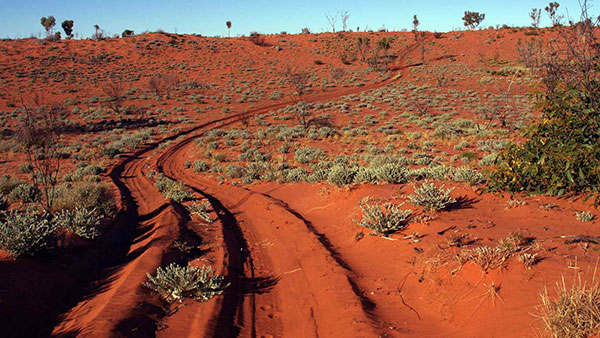
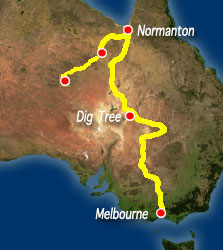
Diamantina Touring Commpany strongly believe in the value of travel insurance. You can purchase NIB Insurance (Australia Limited) policies issued via the link below. You can use this link to purchase travel insurance not only for Diamantina expeditions, but for any travel you want to do anywhere in the world. This insurance is underwritten by XL Insurance Company SE, Australia branch (ABN 36 083 570 441) A Product Disclosure Statement should be considered before acquiring this product..
A prize of 2000 pounds had been set for the first person to successfully cross the Australian continent from south to north. Although this was a large sum at the time, only two men set out to try and receive it. One of them was John McDouall Stuart. The other was Robert O'Hara Burke. Burke was chosen to lead the expedition by the Royal Society of Victoria, which hoped to beat Stuart, who was supported by South Australia. It became the great race. The Victorian expedition would be the best-outfitted and most expensive expedition of its kind. Camels were imported from India. The expedition was organised by the Royal Society, and thats where our expedition will begin with an evening of welcome drinks and nibbles in the grand old building where the bodies of Burke and Wills laid in state on their return from Coopers Creek.
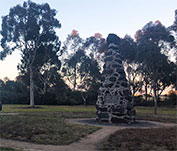
Departure from Royal Park
The expedition set out from Melbourne on August 21, 1860, and three months later, burdened by some 20 tons of equipment reached Menindee, at the frontier of the known world, where second in command George Landell, the expedition’s flamboyant camel master left after a disagreement with Burke. Young William Wills, expedition surveyor and scientist took his place. Burke split up the group, eight men among which Burke himself would push on to Cooper's Creek, while the rest would remain in Menindee. After arrival at Cooper's Creek, Burke sent Wright back to get the rest of the expedition. Burke grew impatient waiting under the coolabahs, and although Wright had not yet returned, on December 16, Burke, Wills, John King and Charlie Gray left Cooper's Creek for their trek to the Gulf of Carpentaria. William Brahe was left behind at the camp, and told that they expected to return in three months.
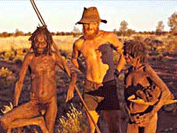
The expedition collapses
They made excellent progress north, and on 9 February 1861 they reached the delta of the Bynoe River, where they were close enough to notice the tide and ascertain its closeness. The voyage back was extremely wet, and they had problems continuing because of heavy rains and lightning storms. They were short of provisions and Burke assaulted Gray when he was caught stealing provision. Grey grew ill, although the others thought he was just pretending, and he died of suspected dysentery on April 17 probably at Lake Massacre. On April 21 they reached the Cooper. Unfortunately, they found it deserted. Wright and his extra supplies had never arrived, and Brahe, having waited one month longer than the three he had been told to, had left the camp just eight hours before they arrived. The day that had been spent burying Gray had proved fatal.

Brahe buried some supplies in case they would come back beneath the now famous dig tree. Wills and King wanted to try to overtake Brahe, who was only miles away from them, but Burke decided against it. They and their camels were much weakened and it would be impossible Instead they would try to reach Mount Hopeless, the nearest outpost of civilization, some 300 miles south west at the tip of the Flinders Ranges. The men set out for the southwest, but found themselves running around in circles. They lived on nardoo, a type of grass seed, and some fish native mammals and birds, but the men grew weaker and the aboriginals that had helped them travelled on..
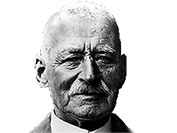
Burke and Wills died of malnutrition in late June 1861, King was cared for by a group of aboriginals until a rescue party found him. Brahe, in the meantime, had met Wright who had finally set out, and returned to Cooper's Creek on 8 May. However, Burke, Wills and King had removed all traces of their presence to avoid the aboriginals from removing the note they had written. He did not check the provisions he had left behind, and returned convinced that the four men had not been at the camp. Tragically, Burke, Wills and King were only a few miles away at the time.
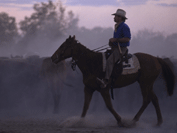
The Rescue Missions,
Several rescue missions were mounted. The South Australian Government sent experienced pastoralist and bushmanJohn McKinlay north. After lengthy searching he found some human remains that were perhaps Charlie Gray. He surmised perhaps the whole expedition had met their deaths here and named the place Lake Massacre. Queensland sent William Landsborogh to the gulf with instructions to make for Central Mt Stuart. In 1861 Alfred Howitt rode north to Menindee and on to Coopers Creek. He located the Dig Tree then downstream he found the only survivor - King. He waited until King was fit enought to travel and returned to Melbourne. Howitt returned the following year and recovered the remains of Burke and Wills.
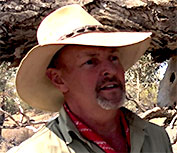
Diamantina has enlisted Dr. Dave Phoenix to lead the expedition. Dave is an acknowledged expert on Burke and Wills, even attaining a PhD on the subject. Dave has walked the full length of the track and has written books on Burke and Wills. Dave is an engaging speaker, talented bushman and a great all round raccounteur. He will unpack the incredible saga of The Victorian Exploring Expedition in a very detailed and highly entertaining way as we head north, telling the story at the very places the events occurred..
We pick up from all Melbourne CBD hotels and head out to Royal Park to commence our expedition to cross the continent at the plinth that marks the spot where the original Burke and Wills Expedition set off. At this historic site we will hear some of the speeches and accounts of the spectacle that accompanied the Expeditions departure back in 1860. Through Melbourne peak hour traffic, we turn onto Mt. Alexander Road and shortly pass the site of Camp One at Moonee Ponds. Aside from a detour around Essendon Airport, we faithfully follow Burke and Wills exact route north through Romsey and Litchfield, across the Great Divide to Elmore in Central Victoria. Here we leave the bitumen and the country opens out to vast plains as we follow wheat roads to Terrick Terrick and on to lunch beside the Murray River at Swan Hill. We cross into New South Wales and on to Balranald, then take the Prungle Mail Road to our first nights camp in the Mallee.
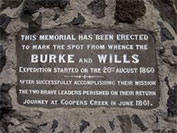
Past Prungle Lakes we continue on through the Cyprus covered dunes of the Willandra Lakes World Heritage area until we reach the Darling. We turn north and head to Pooncarie where we lunch beneath River Red gums on the banks of the Darling. In the afternoon we continue north to the Menindee Lakes. We visit the site of the base camp at Pamamaroo Creek – then on the edge of civilisation. We also visit the Maiden Hotel, on the original expedition known at Pains Pub. Some sections of the original hotel are still standing.
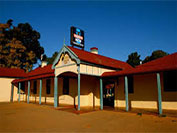
We head west to Broken Hill. After a brief reprovision we follow the Barrier Highway east to Little Topar. Depending on permissions we may head onto Broughton Downs and visit Burke’s Cave, otherwise we will continue north to Mutawintji National Park and take a short walk to visit the cave where Brahe painted his initials over ancient Aboriginal art. We camp in the mulga near Blue Lake Tank.

We travel through some spectacular rangeland, past Noonthorangee Creek affording some grand views of Koonenberry Mountain that so struck Wills on their journey north. We meet the Barrier Highway just south of Packsaddle and continue north to historic Milarinka for a visit to the excellent museum. After lunch we visit Depot Glen, where Charles Sturt was hemmed in by drought in 1844/5. As the waters receded and scurvy set it, one of his party-Poole-died. We visit his grave; beneath the very Grevillea striata they buried him under all those years ago. At Tibooburra we visit the family hotel, where artist Clifton Pugh’s murals adorn the walls of the front bar. The lowering sun turns the iron clad plains of Sturt National Park deep red as we cross the Queensland Border and the Dog Fence at the Wompah Gate and head to camp on the Bulloo Overflow.
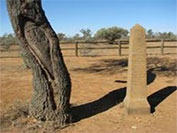
We turn east past Rotten Swamp and shortly come to spectacular breakaway country at Grey Range, looking out over the vast Bulloo Swamp. We descend to Old Tickalara and take station tracks through to Bulloo Downs Station and out to a lonely desolate site on the banks of the Bulloo River at Kooliatto Waterhole where Becker, Purcell and Stone died. We continue on to the town of Thargomindah for a shower and then on to camp beneath the Gray Range near Parragoona Creek.
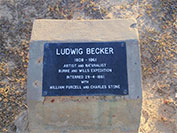
We travel through the oil and gas fields of Nockatunga and Jackson, finally crossing wide floodplain of the Cooper beyond Naccowlah oil field. We lunch at Bullah Bullah Crossing on Nappa Merrie station, the site of the famous Dig Tree. The famous blaze is still visible, and there is a small interpretive museum here. We continue on to Cullymurra waterhole and visit Burke’s memorial at the site where he died. After a stop at Innaminka for an ice cream at the general store or a beer at the pub (whichever takes your fancy) we travel north to camp on the 15 Mile Track..
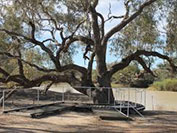
If permission is obtained from Innaminka Station we will travel out to Lake Massacre and camp. McKinlay found some remains of a European there and thought it may have been that of Charlie Gray. At the time he surmised that perhaps the entire expedition had been murdered here, causing him to name the place Lake Massacre. Should permission not be forthcoming we will travel to camp on the Walkers Crossing track.
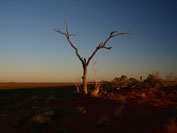
With permission from Clifton Hills Station we will travel out to the Koontchera Dune, a giant sandhill that juts into Goyders Lagoon some twenty kilometres north of the Birdsville Track. Burke and Wills camped at the waterhole here. Our alternative if permission is not granted is to travel to the Page Family gravesite and camp beneath a sandhill near Coocherapoonie waterhole. The Page family perished in 1963 whilst travelling from Marree to Queensland in summer looking for work.
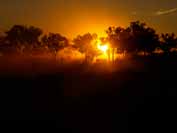
We will travel to Birdsville for showers, provisioning and a tipple at the famous Birdsville Pub. If permission is granted from Durrie Station we will drive across the Bilpa Morea Claypan, past the Plant Camp and then on the Lake Machattie Flood Bypass Road.
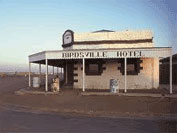
Past the Cacoory Ruins we travel to Whitulania Creek and visit some extraordinary little known Aboriginal Stone Arrangements We will then take the desolate Coorabulka Road northwards to our camp amongst the Acacia Peuce (rare Waddy trees) just south of Boulia.
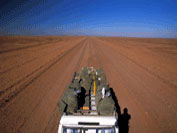
After a visit to Boulia we depart the flat plains Channel Country and take the Selwyn Road via Phosphate Hill to the quaint Duchess Pub. We are travelling through the traditional lands of the feared Kalkadoon Clan. We will camp near Malbon.

We take a short break at Cloncurry before heading north to lunch at the abandoned Quamby Hotel. From here we take the path less travelled across the black soil plains on the Granada-Clonagh Road to the Burke and Wills Roadhouse. We will camp on the Ten Mile Mail Road just north of Mcallister Station.
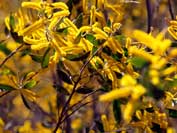
We visit Camp 119 and then with permission travel onto Magowra Station. We head north to the tidal salt and mango flats which mark the furthest point north that Burke and Wills visited.
.jpg)
We return to Magowra homestead and travel to Burketown via Leichhardt Falls. Our camp is at a swimming hole beside the Gregory River south of Gregory.

We travel south to the Camooweal Pub and camp on the Barkly Tablelands.

Our final day we travel down the Sandover Highway to arrive in Alice Springs late afternoon. We have also included a "Day 17" which we will use to shorten one of the longer days during the trip north.
